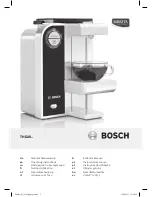
4. DISPENSER DISPOSAL
To prevent possible harm to the environment from improper disposal, recycle the unit
by locating an authorized recycler or contact the retailer where the product was pur
chased. Comply with local regulations regarding disposal of the refrigerant and
insulation.
TROUBLE
CAUSE
REMEDY
3.1 No carbonation.
A. Carbonator motor not running.
B. Absence of CO2 gas.
C. Gas only form valves.
D. Carbonator tank air bound.
E. CO2 gas pressure below 90 PSI
(0.621 MPA).
F. Carbonator motor running
continuously.
A. Check power supply. Be sure toggle
switch is in ON position.
B. Replace with full tank of CO2 gas.
C. Check for power failure. Check fuses.
Clean strainer on pump.
D. Relieve gas pressure in tank by
pulling ring on safety relief valve until
water spurts run out.
E. Reset high pressure CO2 gas
regulator to 90-110 PSI (0.621-0.758
MPA). Change CO2 tank if required.
F. Check switch on carbonator. Check
water in check valve for blockage. Check
carbonator control. Check carbonator
pump for efficiency.
3.2 Noisy Carbonator Pump.
A. Insufficient water supply or water leak,
allowing air to be pulled into pump.
B. Loose pump coupling.
A. Provide adequate water supply. Check
strainer for cleanliness.
B. Tighten set screw on pump coupling.
3.3 Off taste in soda.
A. Leaking water check valve, allowing
carbonated water to back into supply line.
A. Dismantle and clean check valve.
Replace O-Ring, if torn or distorted.
3.4 Valves inoperable
A. Loss of power.
A. Check power supply to see if plugged
in. Check transformer circuit breaker.
Check main power circuit breaker 110V.
NOTE
See Lancer Installation and Service Manual 28-0027/03 for complete troubleshooting information for LEV®
valves and/or Lancer Maintenance Manual 28-0301/02 for complete troubleshooting information for the
Volumetric Valve. These manuals are available on the Lancer web site (www.lancercorp.com).
3. TROUBLESHOOTING
18







































